In January of 2016, The US Department of Housing and Urban Development announced the winners of the National Disaster Resilience Competition (NDRC). Among them was the state of Louisiana, with $48 million in funding earmarked for a project to resettle the inhabitants of Isle de Jean Charles, a small coastal island in Terrebone Parish. Forty miles southwest of New Orleans, the island is home to multiple Indigenous communities including the Isle de Jean Charles Band of Biloxi-Chitimacha-Choctaw and citizens of the United Houma Nation. In a steady onslaught of media coverage, Isle de Jean Charles has been called a “vanishing island,” at once sinking and being overtaken by rising sea levels. Having lost 98 percent of its land mass over the course of the twentieth and early twenty-first centuries, the island is now a narrow strip of land in the bayou, connected to mainland Louisiana by a single access road.
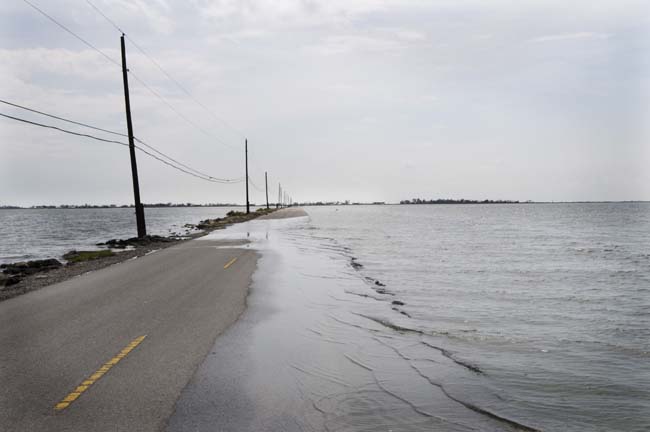
The striking image of Island Road, nearly flush with the water’s surface as it stretches out across the gulf’s open water, has become something of a flexible symbol for the island’s presumed isolation, the fragility of traditional infrastructure in the face of rising seas, and the running countdown on a contracting gulf coastline. Years ago, when filmmaker Benh Zeitlin traveled to Terrebone to scout locations for the movie Beasts of the Southern Wild (2012), he came upon Island Road and followed it to Isle de Jean Charles. The sense of precarity and liminality that enchanted Zeitlin—along with the island’s surreal panorama of dying flora, as its wetlands transform to open saltwater—results from centuries of environmental degradation and dispossession, though those aspects of its history are muted in the film.
This essay is about two islands, one real and one fictional. In tandem, they speak about exposure to harm and the deep interchanges between visual culture and the built environment under capitalism. In the feedback loop between representation and the material world, the membrane between reality and fiction is porous in both directions, and cultural representations of the island and its inhabitants carry implications for the ongoing project to resettle its people. Beasts of the Southern Wild traffics in racialized notions of resilience and environmental harm that have long histories. At the same time, the film posits climate change as the sole catalyst for the island’s circumstances, rendering obscure the histories of violence and environmental racism that have directly shaped its setting.
These histories were again absent from much of the media coverage that came in the wake of HUD’s funding announcement. Since that time, the Isle de Jean Charles resettlement project has become increasingly contested by those it purports to serve. State government and the project’s planners have imposed a typical delivery framework that weakened the role of the island’s communities, reducing Indigenous people to the role of “stakeholders” in an urban planning exercise. Moreover, participation in the resettlement has been structured through a framework of mortgage, a paradigm with deep links to colonist dispossession of Indigenous land. By inscribing the island and the resettlement project within the narrative popularized in Beasts of the Southern Wild—one of rising sea levels and destructive weather—the state fashions itself as a supporter of (so-called) climate refugees while continuing its longer-term project of dispossession.
The Sink
It is difficult to overstate the scale of the extraction operation being carried out along the Gulf Coast. The common description of southern Louisiana as a “working coast” alludes to the nearly continuous presence of industry along the shoreline, evidence of its staggering 90 percent corporate ownership.1 The state’s government has a reputation for accommodating corporate interests and a notorious revolving door between industry and legislative positions.2 The region’s history attests to the state’s complicity in the degradation of its shores.
For more than a century, the Mississippi River and its delta have served as a pollution sink for the industrial and agricultural production in their watershed. As the broader forces of industrialization depleted the delta, so did the immediate destruction wrought by resource extraction. Canals were dug into Louisiana’s marshlands as early as the late eighteenth century, largely intended for the exploration of drilling sites. In the early twentieth century, the presence of oil in coastal regions spurred the seizure and dispossession of land by extraction interests, often through illegal grabs that targeted marginalized and Indigenous peoples. For many years, state regulation was minimal or nonexistent; until the passage of the Clean Water Act in 1973, no state-level permits were required to explore and extract oil, and as recently as the early 1980s, the state of Louisiana maintained no records of where canal dredging had occurred. In a 2017 study by a group of criminological scholars investigating land loss on the island, one government respondent described the tangle of pipelines in the state as a “spaghetti bowl.”3
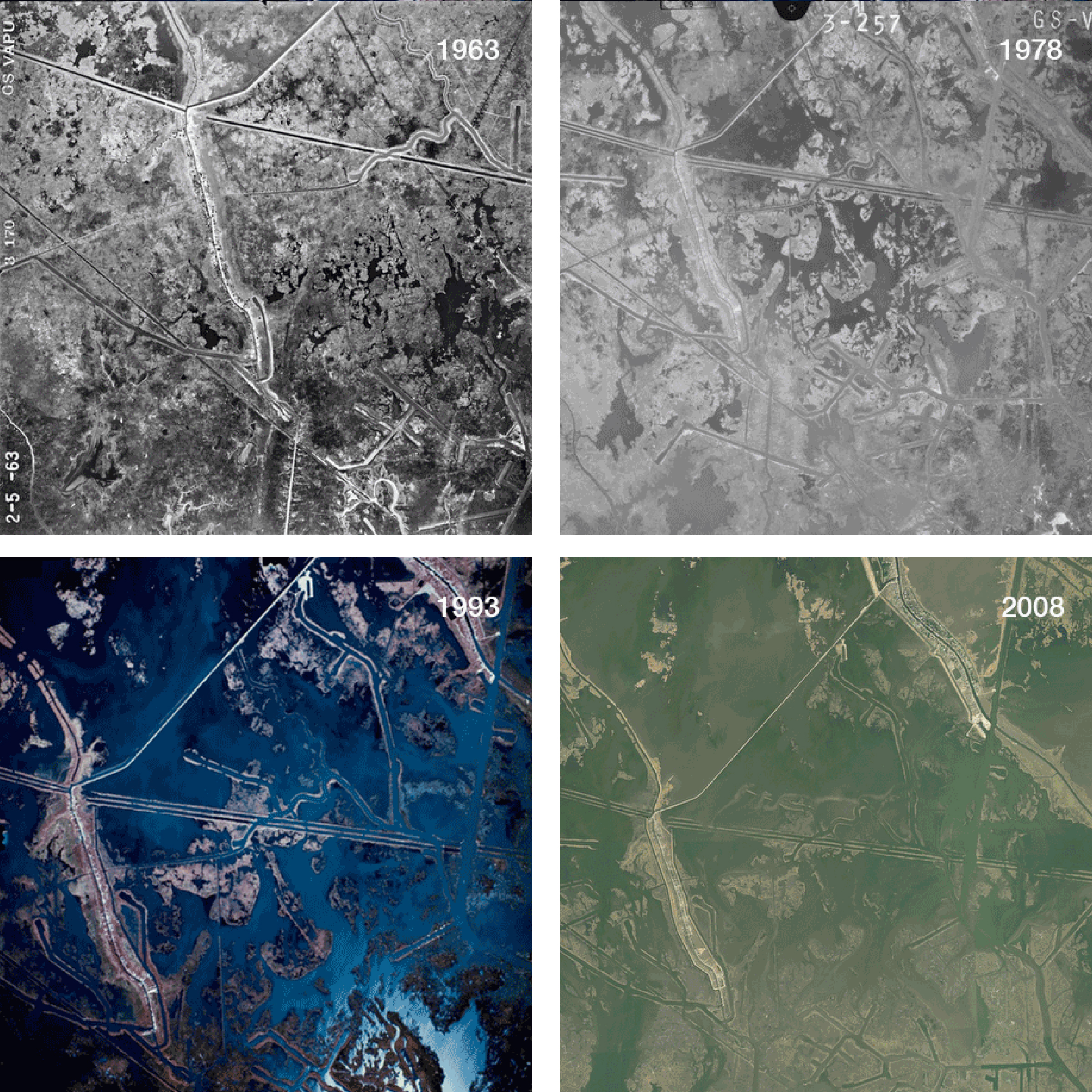
The canals cut into Isle de Jean Charles precipitated the entrance of saltwater into the island’s marshland, speeding erosion and unleashing a multitude of consequences for its ecology. Due to impacts on subsistence farming and fishing, coastal residents eventually sought wage labor to survive; thus, amid the destruction, oil companies became more embedded in local economies as sources of employment.4 In addition to the obvious risk of leaks and spills, oil operations produce harmful effects even when functioning as intended. Exploration and extraction produce copious amounts of waste, expose residents and workers to toxic chemicals, bring radioactive materials to the surface, and degrade air quality.5 On Isle de Jean Charles, proximity to these processes has led to adverse health effects for many who have lived there.6
As social scientist Laura Pulido has described, these effects are unevenly distributed across landscapes and the people who inhabit them: “Industry and manufacturing require sinks—places where pollution can be deposited. Sinks typically are land, air, or water, but racially devalued bodies can also function as ‘sinks.’” For Pulido, this devaluation is part of the way in which capital necessarily produces difference somewhere, sites across which it can expand and unfold.7 The history of Isle de Jean Charles and its coastal region also illustrate how extractive industries, in conjunction with the state, have historically attempted to render Indigenous lands and peoples pollutable.
Traci Brynne Voyles has written that this form of dispossession “involves the exploitation of environmental resources, to be sure, but it also involves a deeply complex construction of [land] as either always already belonging to the settler … or as undesirable, unproductive, or unappealing: in short, as wasteland.”8 In this light, the opening of the coast to extraction and the repeated diversion of the Mississippi, which sped land loss while excluding Isle de Jean Charles from flood protections, is especially significant. By excluding coastal islands from these protections, the state and the Army Corps of Engineers exposed the area to flooding while implicitly depicting it as “uninhabited or unimportantly inhabited,” in a concretization of racist logic.9
The Bathtub
The island’s cinematic incarnation as “the Bathtub” in Beasts of the Southern Wild is, like Isle de Jean Charles, positioned outside of Louisiana’s levee system and on the verge of being overtaken by gulf waters. As a storm approaches, melting ice caps threaten to inundate the Bathtub and release ancient beasts known as aurochs from glacial encasement in an explicit and fantastical reference to climate change. With its proclamations that the Bathtub is “the prettiest place on earth,” and the characters’ refusal to leave their island home, Beasts of the Southern Wild attempts a retort to a “wastelanding” discourse (to borrow Voyles’s term) that would construct its coastal setting as worthless, but in the process indulges in tropes informed by the same cultural logics. Through its construction of the fictionalized island and its central character, a black child named Hushpuppy, the film traffics in notions of resilience and exposure that tie it to a history of deeply racialized environmental representation. For Hushpuppy, this manifests in the film’s relentless treatment of her character amid repeated demands for her to mature as she navigates exposure to precarity, environmental danger, and devastating loss. In an early scene, Hushpuppy and her father, Wink, float on a raft fashioned from the bed of a pickup. Behind them is a dwindling patchwork of marshland, in front of them a massive concrete levee. Beyond, a refinery billows white smoke into the sky. Wink asks his Hushpuppy, “Ain’t that ugly over there?” He answers himself: “we got the prettiest place on Earth.”
The size of the protective infrastructure, and power of the storm it implies, dwarfs the two and their raft in the foreground; the contrast in scale underscores their vulnerable position. In spite of the coming danger, Hushpuppy declares, “Daddy says up above the levee, on the dry side, they’re afraid of the water like a bunch of babies … One day, the storm’s gonna blow, the ground’s gonna sink, and the water’s gonna rise up so high there ain’t gonna be no Bathtub. Just a whole bunch of water.” Though a child, she takes the coming destruction in stride, rejecting the mainlanders’ fear of the water as a failing of character and experience.
Wink’s raft, along with the other ephemeral architecture of the Bathtub, was fabricated by the director and film crew from found objects and equipment near the area where they filmed. The teetering sets project a scene of childlike building onto the Bathtub and its people, a kind of cartoon version of the ad hoc practices required to repair and adapt one’s dwelling in a remote setting. Hushpuppy lives by herself in a trailer raised up on a large, rusted-out barrel and a shifting column of stacked debris. Her home is tethered to her father’s by two thin lines of rope that connect to a dinner bell between the dwellings. In the film’s opening shot, tattered plastic sheeting billows at the windows as wind and tree branches lash the trailer. The home’s metal siding appears lifted at its seams, as if pried by the winds of past storms. The fragility of the set and Hushpuppy’s isolation within it heighten the suspense of the coming storm, tacitly suggesting her imperviousness to harm in the face of imminent danger.
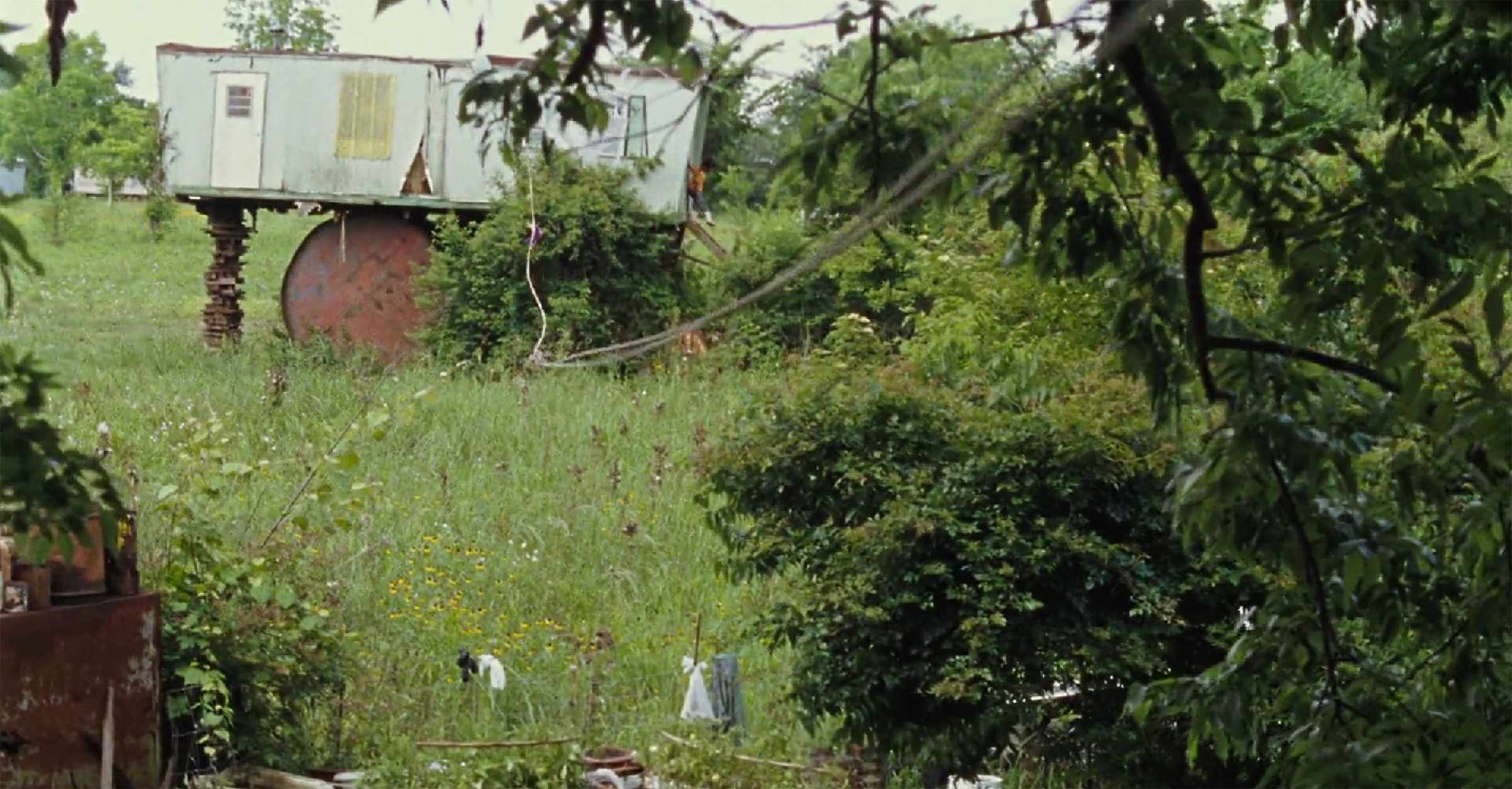
As the storm reaches the Bathtub and rain becomes heavier, Wink and Hushpuppy ready themselves inside of Wink’s house. “Get in the boat,” he tells Hushpuppy, motioning toward an open suitcase on the floor. “If the water gets real high, we’re gonna float to this roof, we’re gonna bust through the ceiling, and we’re gonna ride away.” He secures a pair of floaties to her arms while the wind picks up and the structure racks loudly. The next morning, the camera cycles through motionless shots of flooded homes. Eventually it lands on Wink’s house, half-submerged. After a few moments of uncertainty, a panel in the roof is pushed aside, and he and Hushpuppy emerge to stand atop it, unscathed.
The racialized notion of resilience that the film constructs hinges on the continuous exposure of Hushpuppy, a child, to potential harm. In her analysis of Beasts…, Natalia Cecire has observed that while notions of exposure and imperviousness to environmental harm have historically been racialized, race itself has also been constructed as a mark of environmental exposure, as in “the archaic troping of blackness as a form of sunburn.”10 Such constructions have historically functioned to fuse the denial of full personhood with the supposed imperviousness to harm that might come from having been “exposed,” “marked,” or “seasoned.” Born and raised in the Bathtub, Hushpuppy’s resilience in the film follows this same logic; it is at once inherited characteristic, originary state, and inoculation from her environment. Following in a representational tradition that historically depicted black children as “unfeeling, noninnocent nonchildren,” Hushpuppy’s proximity to danger and exposure to burdensome conditions are normalized throughout the film, her supposed imperviousness to harm bolstered by her geographic and spiritual distance from the mainlanders and the “dry world.”11
In a sequence in which Hushpuppy and other Bathtub inhabitants are moved to a processing center on the mainland, we see Hushpuppy temporarily inhabit this world. After Wink and other residents detonate a segment of the levee in order to drain the Bathtub, state officials descend upon them. Coming upon the group’s camp, they declare the Bathtub a mandatory evacuation area. When Wink and a neighbor resist the forced evacuation, they are violently restrained. At the processing center, Wink’s health, which has declined throughout the film, comes under scrutiny from physicians who press him to undergo emergency surgery. As their conversation unravels into altercation, the scene cuts to Hushpuppy in a playroom with other evacuated children. Now wearing a prim blue dress, she looks warily at her surroundings as a frustrated staff member demands her attention. In these vignettes, the center’s staff seem intended as stand-ins for the state, forcing compliance for the characters’ “own good.” Eventually, the group breaks out of the center and returns home, refusing the state’s paternalistic notions of care. In the end, they march together down Island Road toward the Bathtub, undeterred when the road’s edge disappears under a sheet of water.
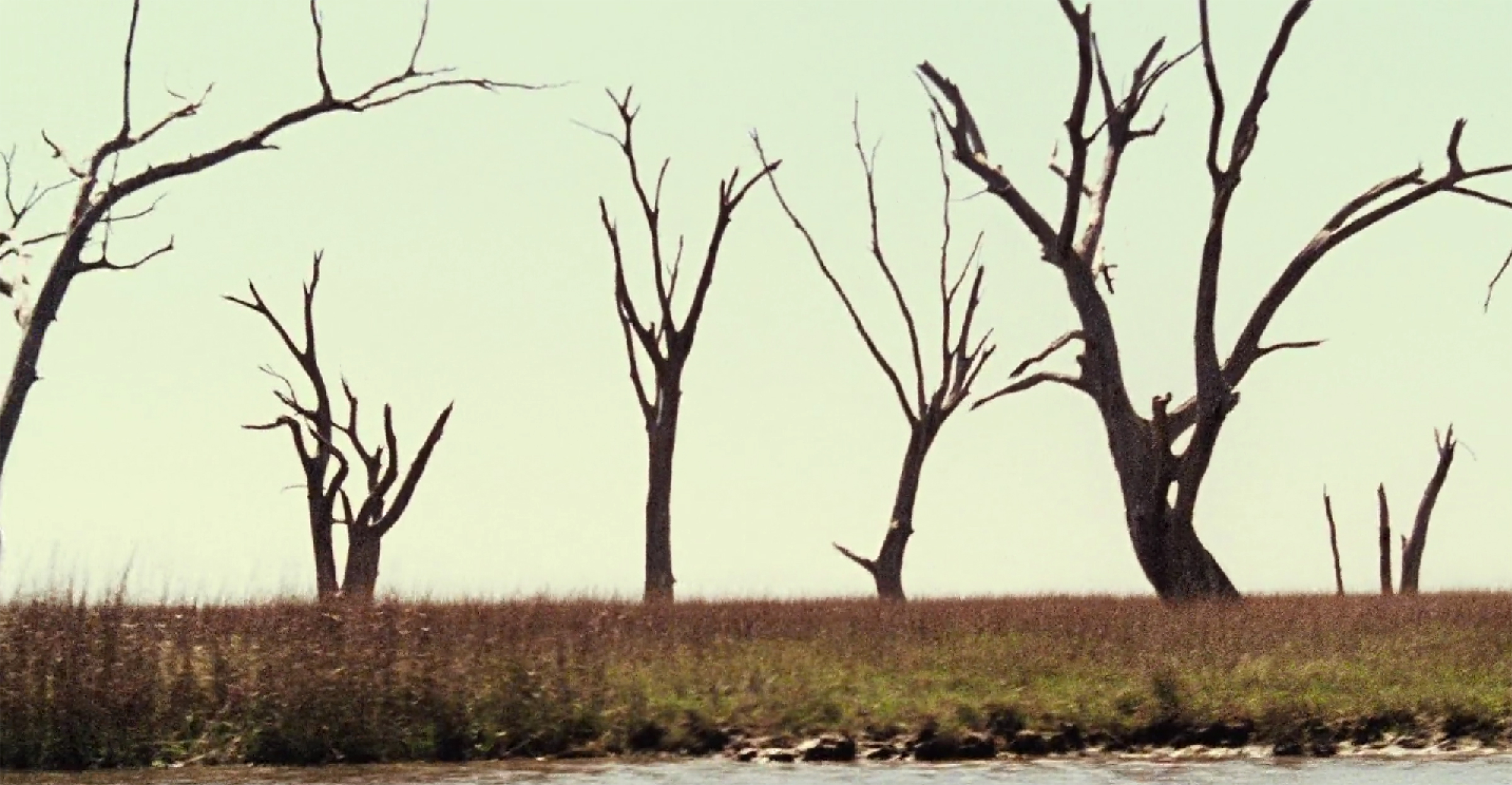
Many years of environmental exposure and racism created the very scenographic qualities that made Isle de Jean Charles appeal to Zeitlin as a setting for his folkloric story of dangerous weather. While Beasts… does attempt to problematize both infrastructure and a paternalistic state through its plot, its accounting of the Bathtub’s crisis presents a generalized version of climate change that emphasizes mainland consumer polluters and rising global sea levels. On Isle de Jean Charles, however, narratives of causation aren’t so easily divorced from settler colonial history, where the state has reliably acted as the servant of capital in its quest for resources. Absent this context, and with a repeated prophecy of the Bathtub’s coming destruction articulated by multiple characters, the conditions at the Bathtub appear ahistorical and at times even mythically ordained—a place at the edge of the world, beyond infrastructure, about to slip under forever.
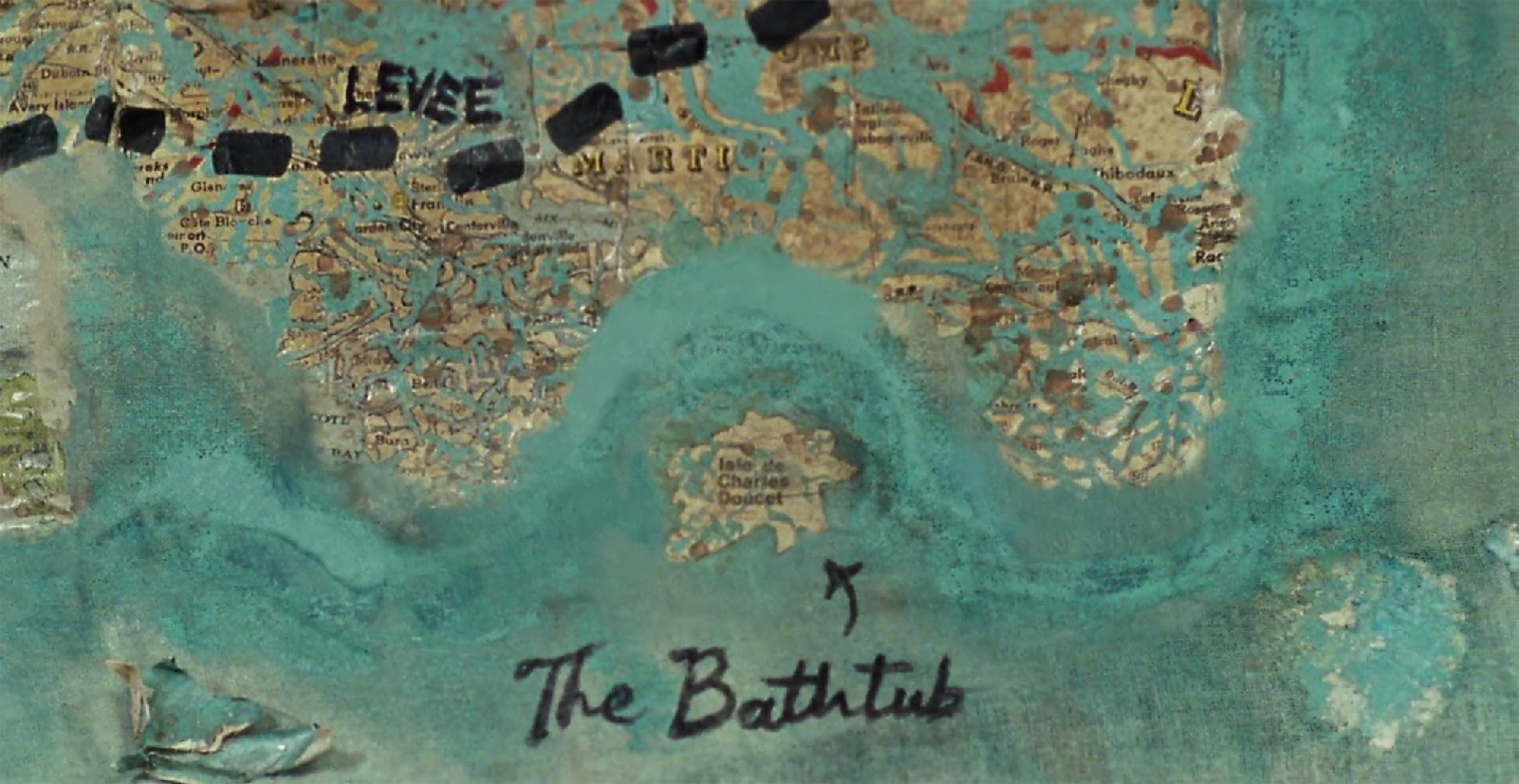
Resettlement
While the characters in Beasts… defiantly proclaim, “we ain’t going nowhere,” on Isle de Jean Charles, questions of leaving and staying are more complex. The ancestors of the island’s Indigenous inhabitants arrived to the area in the wake of forced migration, surviving Indian Removal Act–era policies that systematically and violently forced Native peoples off of their lands.12 As extraction and levee building depleted the island’s landmass, along with damage wrought by severe weather, members of its community began to relocate. More than ten years before HUD rolled out the National Disaster Resilience Competition, the Isle de Jean Charles Band of Biloxi-Chitimacha-Choctaw tribe began work to develop plans for possible resettlement, in order to bring together those still living on the island with members of the tribe who had already left.13 The tribe eventually partnered with the state in an application for funding through the NDRC, resulting in the 2016 award of $48 million.

While it purports to be a project of little to no cost to its participants, the resettlement is nonetheless structured through a creditor-debtor framework. Using no-fee, zero-interest mortgages to secure grant funding, the state offers various paths to resettlement in which deviation from the prescribed terms places participants in default. Default, in turn, can mean foreclosure—not only on homes in the new community but also for existing structures on Isle de Jean Charles. From a certain perspective, the use of mortgages to facilitate property and land relationships is unremarkable, the home mortgage having been normalized in American culture to the point of marking the passage to adulthood within certain social strata. Yet in the context of the Isle de Jean Charles resettlement, it is important to note, as legal scholar K-Sue Park has argued, that the American mortgage is a legal innovation whose history on the continent began with the dispossession of Indigenous land.14
Throughout centuries of English law preceding settler colonialism, the legal frameworks that make land liable for debt were virtually nonexistent. The stability of the existing social order depended on the fact that land was legally distinct from personal property and thus could not be foreclosed upon, thus ensuring the passage of landed estates through family lineages.15 Under the concept of mortgage that developed in the early settler economy, however, such hesitations were discarded.
By adopting forms of currency that held value to Indigenous populations, and laying waste to land and resources, settlers systematically integrated themselves into economic relationships with Native people. They then introduced systems of credit, mortgage, and foreclosure. Park describes the development of these practices:
Colonists extended credit to Indigenous people to draw them into debt, inducing them to then take out “mortgages” on which they would later foreclose. However, when colonists used the imported mortgage form to foreclose, they not only insisted on the English conception of land, ignoring Indigenous understandings of belonging to a place, but they widened the existing breach between English and Indigenous conceptions of land by abandoning age-old English hesitations about treating land in the manner of chattel, thus creating a brand-new American commodity.16
In colonial North America, land became liquid; for the first time, it was equivalent to money and liable for debt. This utilization of the mortgage, writes Park, “would become the essence of its modern incarnation—to alienate land from its inhabitants.”17 It’s important to note that the mortgages used to structure participation in the Isle de Jean Charles resettlement don’t bear the hallmarks of predatory lending. Yet precisely because the loans are offered at no interest and merely forgiven over time, the resettlement illustrates the ways in which the debtor-creditor power relation transcends money in a quantitative sense.
As currently proposed, the resettlement uses a combination of deed restrictions, grant agreements, and mortgages to structure participation.18 The particulars of the various paths available to participants depend on a host of factors. In the most straightforward option, individuals enter into a no-fee mortgage that is forgiven over a five-year period provided they remain in compliance with its terms, which are to: occupy the new home as primary residence, remain current on property tax payments, and maintain both homeowner’s and flood insurance. Those who own property on the island are subject to additional terms through a deed restriction or additional mortgage. To remain in compliance, they must trade their right to reside in their island home or to make any major “repairs, renovations, or improvements” to the property.19 Those who resettle would be permitted to access the island but only for recreational or ceremonial purposes. In contrast to the aforementioned five-year mortgages for homes in the new community, these on-island home mortgages would remain in effect “for 40 years or until such time that the property becomes open water.”20
Under other efforts to conduct buyouts of disaster-prone areas in the name of resilience, including HUD’s Disaster Recovery Buyout Program, it is often stipulated that vacated land become permanent open space. While this is thought to prevent a cycle of redevelopment and subsequent destruction by future disaster, the buyouts can also function as part of a larger state-sponsored project of demolition and “revitalization,” in which disasters in one place are leveraged as development opportunities elsewhere. Superficially, at least, Isle de Jean Charles is a departure from this standard practice in that its structures won’t be immediately demolished. However, if one is found to be “noncompliant” with the terms of their on-island mortgage, the path would be clear for the state to pursue that home’s seizure and demolition.21 Moreover, by demanding that the community withhold “major repairs” on island structures, the state effectively ensures the structures’ passive demolition through exposure to the elements.
Thus, even when emptied of interest and fees, the mortgage contract allows the creditor to set terms that the debtor must adhere to. For the life of the agreement, it provides a basis for possible dispossession; with the threat of foreclosure present, the debtor’s self-determination is eroded in favor of adherence to the creditor’s terms. Maurizio Lazzarato’s description of this relation illuminates the conscriptive power of debt:
The debtor is “free,” but his actions, his behavior, are confined to the limits defined by the debt he has entered into. The same is true as much for the individual as for a population or social group. You are free insofar as you assume the way of life (consumption, work, public spending, taxes, etc.) compatible with reimbursement.22
In the case of the Isle de Jean Charles resettlement, the language of “participation” and “voluntary resettlement” play an important role in masking the project’s nonconsensual aspects while propping up the neoliberal notions of freedom and choice that Lazzarato alludes to. After HUD funding was announced in 2016, previous planning efforts for the resettlement that had been conducted by the Isle de Jean Charles Band of Biloxi-Chitimacha-Choctaw were laid aside, and contracts for new programming and masterplanning phases were executed. During these phases, the plans for resettlement transformed significantly and are now contested by community members of varying tribal affiliations.23 Both the island’s tribal communities have won acknowledgment from the state of Louisiana and are actively seeking federal recognition. Yet because the tribes are not federally recognized, they are subjected to fair housing laws from which they would otherwise be exempt. This means that the opportunity to own a home in the new development will ultimately be open to anyone, regardless of tribal affiliation or connection to the island.
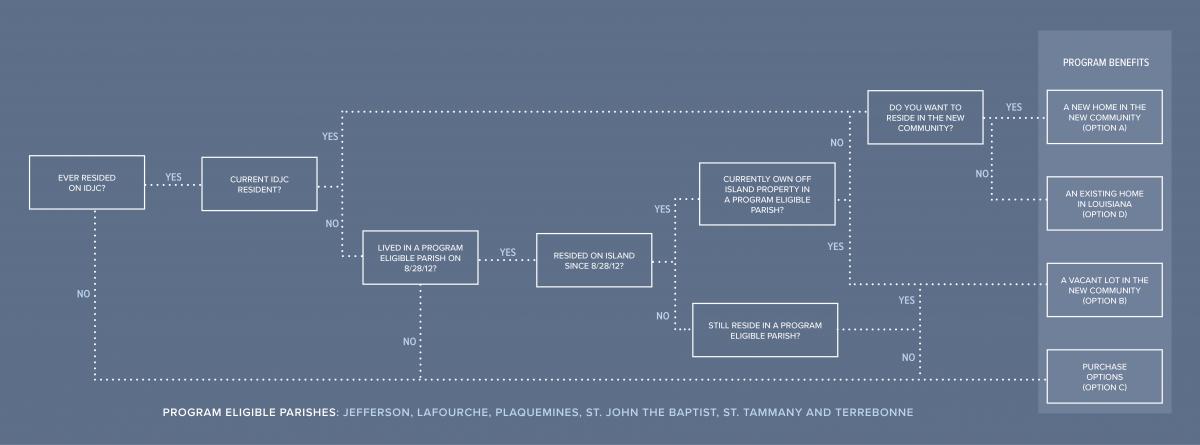
At a Houma-Terrebone Regional Planning Commission meeting in February 2019, attendees expressed objections to the direction the project had taken, along with concerns that the chosen site may have issues with flooding. At the meeting, the planning commission granted their initial approval to the project’s developer, the Louisiana Land Trust. Over the objections of those in attendance, and with an admission that the project had been “hijacked” against the wishes of the tribes, the parish planning commissioner offered the following explanation:
I really firmly believe that the project was hijacked … but I go back to forty-eight million. Forty-eight million’s a lot of money, and it’s a good boost for the economy in Terrebone Parish. … My job tonight is to approve a masterplan … I don’t get to say who lives where, or who agrees with it, that’s not part of my job.24
The commissioner’s comments reveal the compartmentalizing effect of state bureaucracy leveraged in the interest of capital and lay bare an economic opportunism behind the state’s involvement with the resettlement.
The path forward for Isle de Jean Charles and its people is uncertain but increasingly urgent. In the early hours of July 13, 2019, a group of residents were airlifted from the island in the midst of Barry, a tropical storm that ramped up to hurricane status as it neared landfall in the gulf. Many of the island’s residents have resisted the state’s attempts to force the plans through, with some community leaders weighing the possibility of public withdrawal from the project. Back in January, the tribal council of the Isle de Jean Charles Band of Biloxi-Chitimacha-Choctaw released a statement articulating its position: “We are not merely ‘stakeholders’ engaged in a project. We are rights-holders committed to future generations of our family, our knowledge, our ways of life, and our Island people.”25
In its cinematic engagement with displacement and the prospect of resettlement, Beasts of the Southern Wild evokes modes of cultural assimilation that have historically been inflicted on children. During the scenes at the processing center, the transformation of Hushpuppy’s hair and dress, and the staff’s reprimands when she fails to comply with commands, feel like a mandate that she shed any vestiges of Bathtub life. In examining the framework and terms of the Isle de Jean Charles resettlement project, one can see other modes of assimilation with deep ties to old violence playing out in real time.
For this reason, narratives and representation of climate-induced resettlement must be complicated and contextualized by specific histories. An oft-repeated figure from the World Bank estimates that climate change may displace 143 million people over the next thirty years.26 A 2016 study found that 13.1 million people in the continental United States could face migration triggered by sea-level rise.27 Because Indigenous people are disproportionately and uniquely affected by the fallout of climate change, it is essential that state and federal governments be problematized in any efforts to resettle those who are being displaced.
In recent years, climate reports and publications such as David Wallace-Wells’s The Uninhabitable Earth have illustrated that the coming effects of climate change could be nearly unfathomable to the collective imagination.28 Dr. David Carlson, then-director of the World Meteorological Organization’s Climate Research Program, told the Guardian in 2017 that we are seeing “remarkable changes across the planet that are challenging the limits of our understanding of the climate system. We are now in truly uncharted territory.”29 While the environmental transformations currently underway may be unprecedented in human history, questions of land and cultural production allow us to draw out continuities between past and present. In the context of Isle de Jean Charles, uncharted territory turns out to be well worn.
-
Lieselot C. J. Bisschop, Staci Strobl, and Julie S. Viollaz, “Getting into Deep Water: Coastal Land Loss and State-Corporate Crime in the Louisiana Bayou,” British Journal of Criminology 58 (2018): 891. ↩
-
For more on political corruption in Louisiana’s government, see ProPublica’s series, “Louisiana’s Ethical Swamp,” link. ↩
-
This description and much of this historical outline have been drawn from Bisschop et al., “Getting into Deep Water,” 891–899. ↩
-
Bisschop et al., “Getting into Deep Water,” 891. ↩
-
Dara O’Rourke and Sarah Connolly, “Just Oil? The Distribution of Environmental and Social Impacts of Oil Production and Consumption,” Annual Review of Environmental Resources 28 (2003): 595. This and other sources were accessed through the NYC Stands with Standing Rock Collective’s Standing Rock Syllabus Project (2016), link. ↩
-
Bisschop, et al., “Getting into Deep Water,” 892. ↩
-
Laura Pulido, “Geographies of Race and Ethnicity II: Environmental Racism, Racial Capitalism, and State-Sanctioned Violence,” in Progress in Human Geography, vol. 41, no. 4 (2016): 5–6. ↩
-
Traci Brynne Voyles, Wastelanding: Legacies of Uranium Mining in Navajo Country (Minneapolis: University of Minnesota Press, 2015), 7. ↩
-
Voyles, Wastelanding, 10. ↩
-
Natalia Cecire, “Environmental Innocence and Slow Violence,” WSQ: Women’s Studies Quarterly, vol. 43, no. 1–2 (2015): 169. ↩
-
Robin Bernstein, Racial Innocence: Performing American Childhood and Race from Slavery to Civil Rights (New York: New York University Press, 2011), 32. ↩
-
Julie Dermansky, “Louisiana and Isle de Jean Charles Seek to Resolve Differing Visions for Resettling ‘Climate Refugees,’” DeSmog, February 5, 2019, link. ↩
-
K-Sue Park, “Money, Mortgages, and the Conquest of America,” Law and Social Inquiry 41 (2016): 1,006–1,035. ↩
-
Park, “Money, Mortgages, and the Conquest of America,” 1,010–1,011. While charging interest on loans was prohibited, according to Park, an eleventh-century legal tool called a gage entitled creditors to “rents and fruits of the land.” A mort gage (“dead pledge”) was distinct from a vif gage (“living pledge”) in that it allowed the creditor not to apply the land’s yield toward the payment of the debt. This more exploitative version is the forbearer of contemporary mortgage. ↩
-
Park, “Money, Mortgages, and the Conquest of America,” 1,024–1,025. ↩
-
Park, “Money, Mortgages, and the Conquest of America,” 1,012. ↩
-
Detailed information about the resettlement proposal and the various options for participation is publicly available at link. ↩
-
“Isle de Jean Charles Resettlement: What Will Be Required to Participate?” (State of Louisiana, Isle de Jean Charles Resettlement Program, 2019), 2, link. ↩
-
“Isle de Jean Charles Resettlement,” 2. ↩
-
“Isle de Jean Charles Resettlement,” 2. ↩
-
Maurizio Lazzarato, The Making of the Indebted Man (Los Angeles: Semiotext(e), 2012), 31. ↩
-
For extensive coverage of the resettlement project’s execution and its contestation by residents, see Julie Dermansky, “Critics Say Louisiana ‘Highjacked’ Climate Resettlement Plan for Isle de Jean Charles Tribe,” DeSmog, April 20, 2019, link. ↩
-
Dermansky, “Louisiana and Isle de Jean Charles Seek to Resolve Differing Visions for Resettling ‘Climate Refugees,” link. ↩
-
The Isle de Jean Charles Biloxi-Chitimacha-Choctaw Tribe and Tribal Council, “The Isle de Jean Charles Tribal Resettlement: A Tribal-Driven, Whole Community Process,” news release, January 15, 2019, link. ↩
-
Kanta Kumari Rigaud, et al., “Groundswell: Preparing for Internal Climate Migration,” The World Bank, Washington, DC, 2018, link. ↩
-
Mathew E. Hauer, Jason M. Evans, and Deepak R. Mishra, “Millions Projected to Be at Risk from Sea-Level Rise in the Continental United States,” Nature Climate Change 6 (2016): 691–695, link. ↩
-
“Global Warming of 1.5 C,” IPCC Special Report, October 2018, (link: https://www.ipcc.ch/sr15](https://www.ipcc.ch/sr15z text: link). ↩
-
Damian Carrington, “Record-Breaking Climate Change Pushes World into ‘Uncharted Territory,’” the Guardian, March 21, 2017, link. ↩
Alison Brunn is an architectural designer and researcher based in Des Moines, Iowa. She holds an MArch from Iowa State University and a BA in economics from Hunter College.

